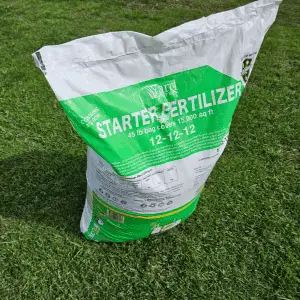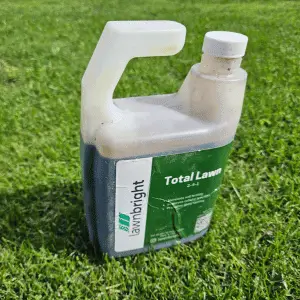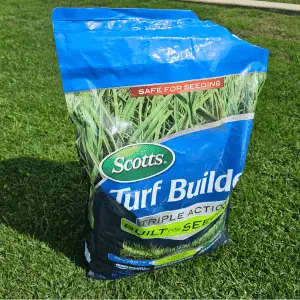I get asked a lot both over on my YouTube Channel and in my email inbox which starter fertilizer I think is best for lawns of all different varieties as well as for sod. Although each grass type has it’s own needs there isn’t a lot of differences in which starter fertilizer I recommend for grass seed versus sod.
Some grass types like Centipede, KBG, or Zoysia grow from seed so slowly that it not advised to apply fertilizer when you sow seed but instead when the seed starts to germinate sometimes 2-4 weeks later. Also certain grass types like the fine fescues or Centipede don’t need as much NPK as other grass types like Bermuda or Perennial Rye.
When sod is installed the grass is already alive and growing but the root systems have been cut off so these plants need to be watered and fed appropriately to push deep rooting.
My absolute favorite starter fertilizers are balanced containing equal amounts of N, P, & K and they aren’t overloaded with synthetics. Applying too much fertilizer to grass seed, sprouts, or new sod only results in waste of nutrients and ground water contamination.
When humic acids are included in starter fertilizer this can help a lot in building up the surrounding soil biology while also helping with moisture management and nutrient uptake.
Lastly, I think every good starter fertilizer should contain a meaningful helping of micro-nutrients such as Iron, Zinc, Manganese, Magnesium, Calcium, etc. All grass systems need these micros and when they are available right from the time of seeding you can be sure your new lawn will be healthy right from the start.
Hands-down, the best starter fertilizer for most people growing new grass from seed or sod is the YM 12-12-12 blend with micro-nutrients & Bio-nite, an ingredient used to build up soil biology in the lawn. This product lacks humic acids but those are easy and cheap to apply at the time of seeding or anytime after germination with a separate liquid or granular product.
You can price out the YM 12-12-12 starter fertilizer here…but there are a couple additional starter ferts that I think are better for some people that have unique situations which I’ll go into below.
I’ll also provide my thoughts on a few good alternatives the the YM 12-12-12 in case it’s out-of-stock at any point or for anyone that needs a smaller bag or a cheaper product.
The Five Best Lawn Starter Fertilizers (Reviews To Follow)
As I mentioned above there are a handful of starter fertilizer products I recommend most. Below I’ve listed all five in order of preference. Scroll past this list to see my comments on each product and why I’ve included it in this list and why. FYI – Each of these links are affiliate links.
1. YM 12-12-12 W/ Bio-Nite & Micros (Click To Jump To My Review)
2. Lawnbright Fish Emulsion Starter 2-4-1 (natural) (Click To Jump To My Review)
3. Scotts Turf Builder Triple Action 21-22-4 For Seeding W/ Weed Preventer (Click To Jump To My Review)
4. Ferti-Lome 9-13-7 New Lawn Starter Fertilizer W/ Micros (Click To Jump To My Review)
5. Andersons 18-24-12 Turf Starter Fertilizer (Click To Jump To My Review)
6. Southland Sod Farms 15-15-15 Sod and Seed Starter (Click To Jump To My Review)
An Important Note About Weed Prevention
With the exception of the Scott’s product linked above none of these products contain a weed preventer in the package. In fact there is only one weed preventer that can be used at the time of seeding a lawn and even then only some grass types can use it.
Mesotrione can be applied to cold season grass types with the exception of fine fescue and only some of the warm season grass types. You can buy mesotrine on it’s own via a liquid product called Tenacity or through a generic version called MESO 4SC Select which is usually a tad bit cheaper in price.
See the pricing for generic Tenacity here to prevent weeds when seeding grass or the following article for more info on using pre-emergents while seeding.
Now let’s look at each of these five grass starter fertilizers up close. I’d like to explain why they are on this list; what makes them worth using, and why I’ve ranked some higher than the others.
Yard Mastery 12-12-12 W/ Bio-Nite & Micros
This product tops my list of recommended starter fertilizers for grass seed because it meets most of my desires when it comes to growing grass from seed.

It’s a balanced fertilizer that isn’t overloaded with Nitrogen and it has enough Potassium to encourage overall plant health. The Potassium is the premium version found in ORMI certified organic products too.
Although this bag doesn’t come with humic acids or any bio-stimulants like sea kelp it does come pre-loaded with micronutrients which are not commonly found in starter fertilizers even though new grass needs micronutrients.
The Bio-Nite in this product is likely a small portion of the mix but what is in there will aid a bit in keeping the soil biology in your lawn space active while your grass roots are growing – anything that makes for healthier and more vibrant soil is worth it.
The only think I would change about this product is the Nitrogen source which is a bit too fast acting for my taste. Because it is sourced from ammonium sulfate it may work it’s way deep into the soil faster than your roots can grow. A slower release coated urea, or organic source like blood meal or feather meal would be great for fall seeding…however the ammonium sulfate will be useful for early spring seeding when the other sources will be too slow to become plant available.
Overall I like this starter fertilizer the best and when paired with an optional shot of cytokinins (see notes at bottom of this page) soon after germination and a top-dressing of alfalfa meal, both of which stimulate more substantial root development, it’s hard to beat the YM 12-12-12.
Total Lawn Fish Emulsion Starter Fertilizer
By far and away the best natural starter fertilizer is a fish emulsion as this type of product delivers slow-release macro-nutrients heavy on Phosphorus along with a ton of off-label micronutrients, amino acids, and trace minerals.

The Total Lawn product also contains an ample amount of kelp extracts giving you enough bio-stimulant activity to push extra rooting when it’s needed most and can be paired with the Black Gold or RootRx product to get extra micronutirents, trace minerals, and humic acids.
If you choose to use Lawnbright’s products you WILL end up having healthier grass with deeper roots and your lawn will hold up better to stresses like summer heat, drought, foot traffic, disease pressure, and winter dormancy but you won’t have as fast leaf growth…so if you liek mowing the lawn often or liek spending as little as possible then this won’t be the right product for you.
For me, this is my go-to natural product and it’s also conveniently the easiest one to apply to smaller lawns, those sized around 1k-3k square feet per zone.
Scotts Turf Builder Triple Action 21-22-4 For Seeding W/ Weed Preventer
I’ve placed this Scott’s starter product on the list, not because everyone knows the Scott’s brand, but because this is one of the only options many people have available for preventing weeds from germinating during the seeding process.

This is a fairly expensive product for the coverage you get but because of the included Mesotrione you don’t have to be tempted to buy Tenacity (a weed preventer) for application at time of seeding.
The biggest drawbacks of this product (other than it’s higher price) is that it only contains 4% Potassium by weight compared to 21% and 22% for N and P.
I really don’t like starting seed without getting a good amount of K on the seedbed. There’s no doubt it’s easier to stop weeds when using this product and without having to fiddle with a sprayer to apply liquid Mesotrione it’s an easier sell to apply an extra top-dressing of straight granular Sulfate of Potash (SOP) to up the Potassium being delivered to the seedlings.
If you do choose to go this route make sure to pick up a granular SOP to feed the grass what it actually needs to put on healthy growth. Here is a cheap option available on Amazon and a premium option that’s easier to spread over on Yard Mastery.
Ferti-Lome 9-13-7 New Lawn Starter Fertilizer W/ Micros
The Ferti-Lome product is ranked high on my list because it is also a starter fert that doesn’t contain too much Nitrogen and also does contain a lot of Potassium meaning the Nitrogen applied is less likely to leech away through bare soil prior to germination and the seedlings that do emerge will be healthier…especially due to the micro-nutrients included in the bag.
This product isn’t a balanced product but the NPK ratios look good to me nevertheless and the nitrogen source is mostly urea meaning it will only become plant available when soil microbial life breaks it down. This slows it’s availability a few days making this a better product to use in overseeding a lawn where we don’t want to push the existing grass too much too fast.
I do wish this product contained the SOP version of Potassium instead of the MOP version but this is just a small gripe.
The bigger wish I had was the lack of a bio-stimulant like tricontinol which is naturally found in alfalfa meal or the inclusion of a small bit of humic acid.
This product is also a great option for people that are seeding smaller spaces or smaller lawns because you can get it in a variety of bag sizes potentially keeping your costs a lot lower and limiting waste or extra product that has to be stored.
► Pricing and availability for this product can be found here.
Andersons 18-24-12 Turf Starter Fertilizer
This option is best for people that are seeding a large area and don’t really want extra “stuff” in the bag.
This product has a lot more Phosphorus in it than Nitrogen so it meets my needs as a lower Nitrogen fert that won’t push top-growth too fast when applied at lower rates.
I do wish the Potash or K contents were higher but they still dwarf many easily found options on the shelves of big-box stores everywhere.
Considering how much coverage you get out of this bag the price is actually quite good…but only if you plan on using the majority of it and don’t have to store extra for years in your garage.
► Pricing and availability for Anderson’s 18-24-12 can be found here.
Southland Sod Farms 15-15-15 Sod and Seed Starter
This is another great option that meets the balanced fertilizer ratio I want to see at the time of seeding. It’s only the big-three macro-nutrients however so you don’t get any micros at all.
For those that end up buying and using this product I recommend applying an extra application of micro-nutrients and/or an application of Azomite for trace minerals and nutrients (see notes at the bottom of this page).
For people with average size yards this is a good way to save money over the fancier stuff listed above on this page but still put down a better product than most basic (cheap) starter lawn food mixes found in lawn and garden departments locally.
► Pricing and availability for Southland’s 15-15-15 can be found here.
Starter Fertilizer FAQs & Seeding Advise
I get a lot of questions about seeding lawns and applying starter fertilizers. I’ve answered many of those questions here on the site in other articles.
I highly recommend you read my article on applying starter fertilizer to established lawns and this article on applying it to new sod.
I also have provided advice on fertilizing an overseeded lawn here.
If you’ve never seeded a lawn before then see my article on seeding a new lawn for a lot of helpful tips.
How To Make Starter Fertilizer Work Better – BioStimulants
When seeding new grass you want to supply the nitrogen to get the grass blades growing, the phosphorus to get the roots growing, and potassium to keep the pant system healthy but applying bio-stimulants can help push the plant to focus more of it’s energy on root development and root mass.
The most common additions to starter fertilizer include products that contain cytokinis, a growth hormone produced by all plants but in large quantities by sea kelp. I apply cytokinins to my lawn and my new seedlings using a product called CytoGro although many people use a more commonly purchased product called RGS to get seaweed or sea kelp extracts packaged together with humic acids.
I also apply alfalfa meal to all my seedbeds for the naturally occurring triacontinol and Azomite to ensure my soil has all of the trace minerals possible for new grass to thrive.
You can read more about these naturally occurring seeding and rooting additives and bio-stimulants on my product recommendations page here.

